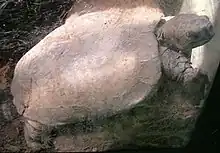| Arakan forest turtle | |
|---|---|
 | |
| Arakan forest turtle in Atlanta Zoo | |
| Scientific classification | |
| Domain: | Eukaryota |
| Kingdom: | Animalia |
| Phylum: | Chordata |
| Class: | Reptilia |
| Order: | Testudines |
| Suborder: | Cryptodira |
| Superfamily: | Testudinoidea |
| Family: | Geoemydidae |
| Genus: | Heosemys |
| Species: | H. depressa |
| Binomial name | |
| Heosemys depressa | |
| Synonyms[2] | |
| |
The Arakan forest turtle (Heosemys depressa) is a critically endangered turtle species native to the Arakan Hills in western Myanmar[1] and the bordering Chittagong Hill Tracts in Bangladesh.[3] The Arakan forest turtle is a semiterrestrial turtle, meaning it can survive in aquatic as well as terrestrial habitats, but adults prefer living in terrestrial habitats.
Taxonomy

Geoëmyda depressa was the scientific name proposed by Anderson in 1875 who described a zoological specimen collected in Arakan.[4]
Characteristics
The Arakan forest turtle has 18 plastral annuli, a carapace length of 22 cm (8.7 in) and weighs 1.3 kg (2.9 lb).
Distribution and habitat
In 2009, the Arakan forest turtles was discovered in Rakhine Yoma Elephant Range in Myanmar. The scientific team also labeled the area as a good prospective place to focus conservation efforts for the turtle, despite the fact that locals do occasionally hunt and eat them. Even with those activities, this protected area is difficult to access and lacks any human settlement, making any human interference with the turtle merely opportunistic. No large-scale commercial project hunts the turtle, nor would there be a demand for one, since the turtle is too difficult to find compared to the little profit there is for doing so. Furthermore, the area even has a low risk of being exploited for natural resources.[5]
In 2015, a potential population was discovered during a non-governmental organization's citizen science project, suggesting a population of the Arakan turtle may reside in the Chittagong Hill Tracts.[6]
Behaviour and ecology
The Arakan forest turtle is active at night and increases its activity during the early wet season. Local hunters found eggs in June and July when skinning female specimens, possibly revealing the reproductive system and cycle of the species.[5] It remains dormant the majority of the time and hides in leaves and debris. It is an omnivore, feeding on both animals and plants. Although it is considered a relatively reserved animal for the majority of its daily activity, it is aggressive when it comes to eating insects, worms, and fish. It also consumes fruit that falls to the forest floor.[7]
Threats
Arakan forest turtles are being traded by animal pet dealers in China, who catch them in western Myanmar. In 2003, researchers took samples for research from nine Arakan forest turtles that had been imported to the Czech Republic to be kept in a private collection.[8]
Conservation
In captivity
As of 2009, a small number of turtles were present in captivity, and as of 2009, only the Zoo Atlanta has successfully bred the turtles in captivity.[9]
References
- 1 2 3 4 Platt, K.; Rahman, S.C.; Horne, B.D.; Praschag, P. (2020). "Heosemys depressa". IUCN Red List of Threatened Species. 2020: e.T39596A2929864. doi:10.2305/IUCN.UK.2020-2.RLTS.T39596A2929864.en. Retrieved 8 February 2022.
- ↑ Uwe, F. & Havaš, P. (2007). "Checklist of Chelonians of the World". Vertebrate Zoology. 57 (2): 149–368.
- ↑ Rahman, S. C.; Rashid, S. M. A.; Datta, R. & Roy, C. J. (2015). "Status, exploitation, and conservation of freshwater turtles and tortoises in Chittagong Hill Tracts, Bangladesh". Chelonian Conservation and Biology. 14 (2): 130–135. doi:10.2744/CCB-1146.1.
- ↑ Anderson, J. (1875). "Description of some new Asiatic mammals and Chelonia". The Annals and Magazine of Natural History; Zoology, Botany, and Geology. 4. 16 (9): 282–285.
- 1 2 Platt, S. G.; Myo, K. M.; Ko, W. K.; Maung, A.; Rainwater, T. R. (2010). "Field observations and conservation of Heosemys depressa in the Rakhine Yoma Elephant Range of western Myanmar" (PDF). Chelonian Conservation and Biology. 9 (1): 114–119. doi:10.2744/CCB-0813.1.
- ↑ "Locals lead scientists to new population of near-extinct reptile". Mongabay Environmental News. 2015. Retrieved 2022-02-02.
- ↑ "Arakan Forest Turtle". Zoo Atlanta. Archived from the original on 24 March 2014. Retrieved 23 March 2014.
- ↑ Siroky, P. (2006). "Two Eimerian Coccidia (Apicomplexa : Eimeriidae) from the critically endangered Arakan forest turtle Heosemys depressa (Testudines : Geoemydidae), with description of Eimeria arakanensis n. sp" (PDF). Acta Protozoologica. 45 (2): 183–189. Archived from the original (PDF) on 2017-08-11. Retrieved 2012-10-26.
- ↑ "Critically endangered turtles found in Rakhine State (Heosemys depressa)". European Studbook Foundation. Retrieved 2022-02-02.
- Robbins, R. G. and Steven G. Platt. "Proceedings of the Entomological Society of Washington."Proceedings of the Entomological Society of Washington. 103.2 (2001): 1023–1024. <https://www.biodiversitylibrary.org/item/54775>
- Ludwig, M.; Auer, M. & Fritz, U. (2007). "Phalangeal formulae of geoemydid terrapins (Batagur, Callagur, Hardella, Heosemys, Kachuga, Orlitia, Pangshura, Rhinoclemmys) reflect distinct modes of life" (PDF). Amphibia–Reptilia. 28 (4): 574–576. doi:10.1163/156853807782152570.
External links
- "Arakan Forest Turtle". St. Louis Zoo. Archived from the original on 2016-04-09. Retrieved 23 March 2014.
- "Zoo Hatches Endangered Asian Turtle". CNN. 2007. Archived from the original on May 16, 2007. Retrieved 23 March 2014.
- "Arakan Forest Turtle". Atlanta Fulton County Zoo. 2012. Archived from the original on 2014-03-24.

